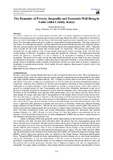| dc.description.abstract | It is hard to imagine an issue in development economics that is of greater importance to humankind than the effects of economic growth on poverty and economic well being. Hence this study is stimulated by the desire to have an in depth knowledge of the key factors that determine regional poverty, inequality and economic well being. This then helps analysts and policy makers to design effective targeting indicators. The major objective of this study is to investigate the profile of income inequality and poverty among identified socio-economic groups. The data used are based on the 1994 Welfare Monitoring Survey (Government of Kenya 1998, 2000). These data
were collected for the whole county and covered nearly 272 households. The existing sub counties were clustered into six agro-regional zones. Using standard proportional random sampling, aided with data from Central Bureau of Statistics, households were randomly sampled for interviews. The fundamental rationale behind the choice of a household as a unit of analysis is the assumption of sharing of resources among households. The results of this study showed that male headed households are less likely to be poor. Similarly, the likelihood of being poor is smaller in urban areas than in rural areas. Probably to some extent related to this, people living in households mainly engaged in agricultural activities are more likely to be poor, compared to households in manufacturing activities. In all models the most important determinant of poverty status is the
level of education. | en_US |

